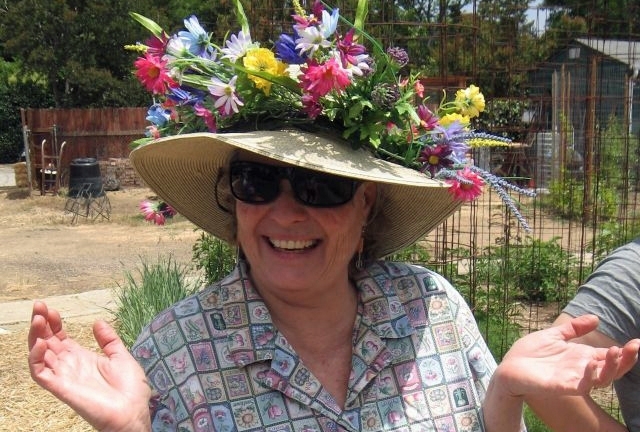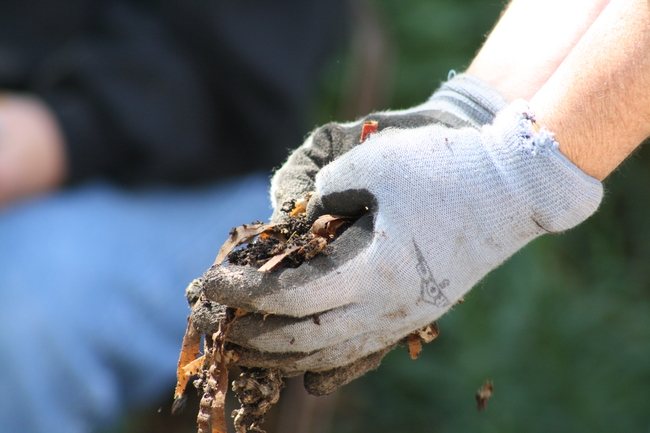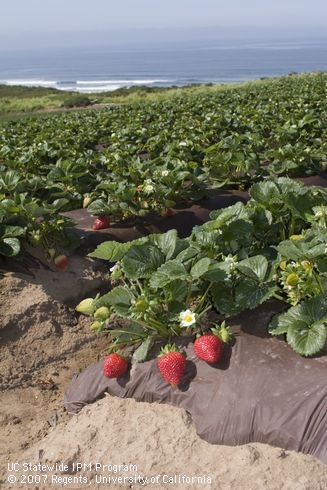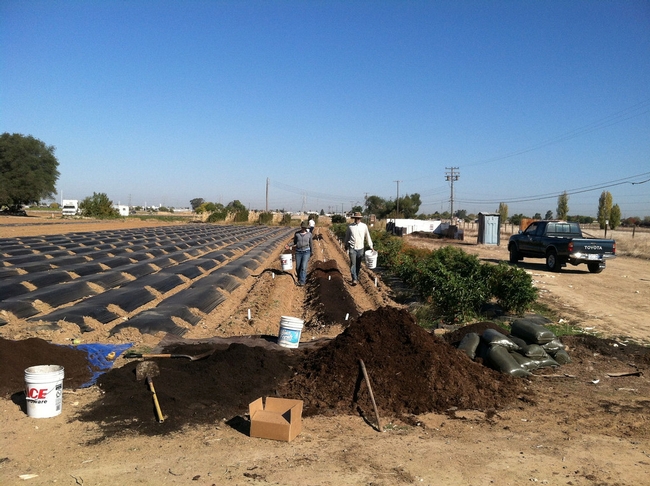Posts Tagged: compost
Build the soil for successful gardening
Before digging in to spring planting, pay attention to building the soil, advises an article in the Los Angeles Times by Jeanette Marantos.
Marantos visited the Pasadena backyard garden of Yvonne Savio, the retired coordinator of the UC Master Gardener Program in Los Angeles County. Savio is the creator of the Gardening in LA blog, with new stories appearing "every other week or so."
“The old saying is, ‘Feed the soil, not the plant,'" Savio said. “When you just use chemical fertilizers, you're not establishing a long-lasting base of nutrition for the plant. It's just giving it a huge piece of cake on Sunday, and then by Thursday it's nutritionally starving.”
Savio recommends a steady diet of organic matter be spaded into soil, and a layer of organic mulch added to the top of soil.
When you continually add organic amendments to the soil, the dirt comes alive as the amendments decompose, creating the beneficial bacteria, fungi and the nutrients plants need to grow strong and healthy, Savio said. “It's really like a cafeteria where your plants can pick and choose what they really like.”
Use compost for water conservation
“Adding compost to your soil on a regular basis increases the amount of water your soil can hold, therefore decreasing the amount of times you need to apply water to your landscape,” says Missy Gable, the director of the UC Master Gardener program, in the final installment of a six-part video series on water conservation in the home landscape.
Compost is organic matter – grass clippings, fallen leaves, spent bedding plants, vegetable peels, coffee grounds, etc. – that has been dampened and turned regularly so it is broken down by worms and micro-organisms. The finished compost, a dark black blend with a pleasant earthy smell, can be mixed into the native soil in the landscape.
Compost improves the soil texture, holds moisture, provides food for beneficial bacteria, and nutrients for plants.
View the video below:
Detailed information about the benefits of compost and instructions for home composting can be found in Composting is Good for Your Garden and the Environment, a UC ANR publication available for free download from the UC ANR publications catalog.
Additional videos in the UC ANR series on saving water in the landscape.
Early-morning watering is best
Remove weeds from your landscape
The videos are also available on the UC ANR YouTube channel.
An initiative to improve California water quality, quantity and security is part of the UC Division of Agriculture and Natural Resources Strategic Vision 2025.
Can compost be an alternative to methyl bromide?
Writing on Earth Day, I am reminded of one of the world's major successes in environmental protection, the Montreal Protocol. Originally signed in 1987, it works to phase out ozone-depleting substanc
es, including the soil fumigant methyl bromide, commonly used by strawberry growers.Twenty-seven years later, the realities of enacting the Montreal Protocol are still taking shape, and strawberry growers are, with each harvest year, a step closer to a complete phase out of the fumigant and increased restrictions on alternative chemical fumigants used for disease suppression.
UC research has focused on how to make an economically viable and effective transition away from the soil fumigant. Initial alternatives include replacement chemical fumigants as well as biological fumigants such as anaerobic soil disinfection (such as putting tarps over fields to decrease oxygen), mustard seed meal amendment, or steam disinfestation.
But what if a practice many growers already use could also serve to suppress soil-borne diseases? What if growers could use a substance that provides multiple on-farm benefits?
Many conventional and organic growers alike use compost to boost soil fertility and organic matter. But compost's potential to serve other purposes, including suppressing disease, remain largely unexplored.
Ph.D. student Margaret Lloyd and Tom Gordon, professor in the Department of Plant Pathology at UC Davis, are hoping to close the gap in that knowledge. With a grant from the National Strawberry Sustainability Initiative, a program administered by University of Arkansas and funded by Walmart Foundation, and funding from UC Sustainable Agriculture Research and Education Program, Lloyd's research seeks to understand whether compost can contribute to disease suppression on a commercial scale, and how growers can best incorporate compost into their farm management to see its benefits.
“Compost is part of the production system that has potential as biological control,” says Lloyd. “Historically, we've only focused on it as a source of organic matter or soil nutrients. I'm trying to characterize its role in root health and soil health.”
The study evaluates the root health of strawberry plants, and compares plant yield and disease suppression across a number of research sites and compost types.
“In general, we talk about compost just as compost,” Lloyd said. “But it has drastically different qualities — soil fertility characteristics, physical properties, and microbial profiles. By focusing on different compost sources, the study will help growers better assess their available compost options to m
eet their farm needs.” Composts used in the study include worm compost, manure-based compost, spent mushroom compost, and municipal yard trimmings compost.Alternatives to methyl bromide have been a long time coming. “The research suggests that it won't be one technology replacing another, but a package of tools to help growers manage disease suppression in the soil,” Lloyd said. If some of those tools are already in a grower's tool kit, the transition away from fumigants will be that much smoother.
The research suggests a powerful Earth Day message for me: use what you have, but seek a deeper understanding of just how to use it.
Lloyd's research findings will be completed in 2014, with results available for growers in 2015. Visit the project's website for more information.
Fall
Fall is a well-named season. Downed leaves are filling rain gutters, carpeting lawns and blowing into the nooks and crannies of yards all over Solano County.
I’ve noticed something that accompanies all those leaves hitting the ground, and it’s just as annoying: leaf blowers.
(I promise this will not be a screed on blowers. They have their place in modern yard maintenance. But do we really have to fire up those blowers at 7:30 a.m. on a Saturday? And, honestly, does anyone rake anymore?)
All of this begs the question: Do we really need to clean up and haul off all those fallen leaves, only to turn around and buy bags of mulch for our yards? What’s the research-based word on using our leaves as “free” mulch? The University of California Cooperative Extension Central Coast & South Region Center for Landscape and Urban Horticulture has created a list of the pros and cons of mulch that’s very helpful. Bottom line: It does indeed pay to use your own leaves as mulch. It helps to control weeds, conserve moisture, moderate soil temperature, enhance water absorption, prevent erosion, and enrich the soil.
The key is to use only healthy leaves. Don’t toss in the mildewed grape leaves or the rust-infested rose leaves. Do consider using those pecan or walnut shells as mulch.
Another suggestion I’ve seen in the quest for successful mulching is a leaf shredder. Or, if you don’t want to go out and pay for a shredder, use your lawn mower to chop up the leaves, gather them up and spread a 2- to 4-inch layer around your plants. Remember, mulch should be used as a top dressing only. Do not mix raw mulch in with your garden soil, as it will deplete the nitrogen level in your soil as it decomposes.
My husband rakes up the leaves on our property and tosses them into compost piles. We eventually get lovely shovelfuls of leaf mold, compost that uses only leaves. Here’s a link to another UCCE article on making leaf mold, which you can use as a soil amendment or mulch.
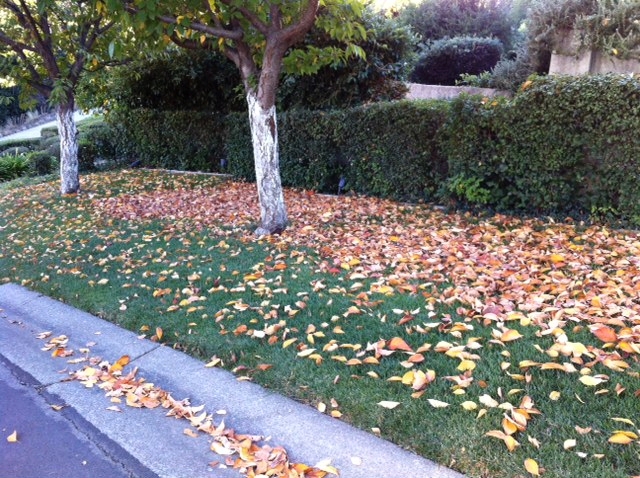
A neighbor’s normally spotless front lawn is barely visible under a blanket of newly fallen leaves. (Photo by Kathy Thomas-Rico)
Real or Artificial? The Choice is Yours.
It's that time of the year again when holiday tree lots begin to set up shop and artificial trees are placed out in the local retailers for sale. As a sustainable gardener I often find myself wondering the age old question, is an artificial tree more environmentally friendly than a real tree? The answer to this question will likely be the basis for my chosen display choice this year so I began to investigate the facts behind both options.
We have had a fake tree for the past 10 years and we are ready for a new one as it is worn out. Some of the issues with artificial trees are that about 95% of them are manufactured in China (including the one I have) and take large quantities of fossil fuel to transport from China to our market here. They are largely made of non-biodegradable plastic and studies show they need to be used at least 10 years to make them an environmentally friendly decision. Most are discarded after an average of only 6 years and then sit in landfills for decades because they don't decompose and cannot be recycled. In contrast, real trees help regulate carbon dioxide while they are being raised, emitting oxygen into our air. They are largely recycled after use creating secondary products like mulch and compost. Real tree farms employ hundreds of thousands of Americans who are dedicated to growing healthy beautiful trees for families to one day idolize, decorate and enjoy memories of. The fossil fuels needed to pick up a local real cut tree are minor compared to a trip over from China.
A downside to some tree farms is the usage of pesticides and fertilizers during production which can pollute ground water and soils of unscrupulous users. My conclusion is that a real tree may be the more green choice when deciding on what kind of holiday tree one displays this season. I will soon be getting in my eco station wagon to take the family down to the real tree lot this year, the first time in a decade, so we can get a real tree. It is always an "experience" and I'll feel better about the reason why I am there this year.
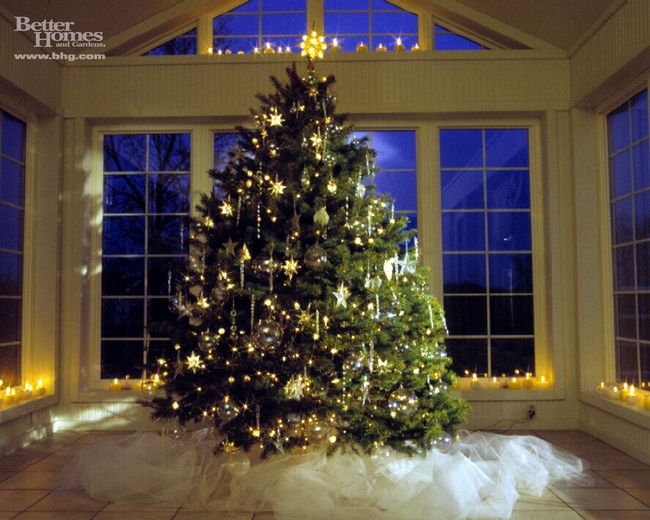
Beautiful Christmas tree. (photo courtesy of Better Homes and Gardens website)


